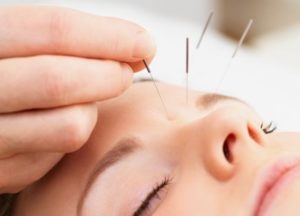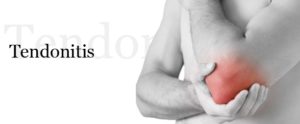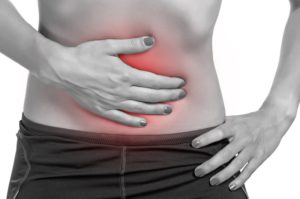
If over-the-counter antihistamines aren’t bringing enough relief, studies show acupuncture helps hay fever. Perhaps the best evidence of its effectiveness comes from a 2013 study published in the Annals of Internal Medicine. German researchers examined 422 people aged 16 to 45, all of whom tested positive for pollen allergies. The researchers divided the participants into three groups: one which received 12 acupuncture treatments, plus antihistamines; one that received 12 treatments of faux acupuncture (meaning the needles were placed randomly instead on proven acupuncture points), plus antihistamines; and one that received antihistamines only.
After two months of treatment, 56 percent of people in the second group reported improvement in their symptoms. However, 71 percent of those treated with real acupuncture as well as antihistamines reported improvement, as well as less use of medication compared to the other two groups.
“I have seen many patients who failed medication and allergy shots respond to acupuncture,” says Dr. Patrick LaRiccia, a doctor of Internal Medicine at the Penn-Presbyterian Medical Center in Philadelphia. “Often patients get some relief during the first visit while lying on the exam table with their acupuncture needles in place.”
Those with mild allergies may only need a few acupuncture treatments to feel substantial relief from their symptoms. However, those with chronic allergies may need to begin with two sessions a week for up to six weeks. “Patients can determine the effective of acupuncture treatment by tracking the number of sneezes per day and the number of itching episodes around their eyes,” Dr. LaRiccia explains. “After an initial series of treatments, patients can come in for further treatments as needed. Some come back once or twice a year for a booster, while others may come more often.”
If allergies stop you from fully enjoying the spring, consider ditching over-the-counter medication in favor of a more holistic approach. Schedule an appointment with a licensed acupuncturist who can design a treatment plan for your needs.

 Remember when you’d have a stomach ache and your mom would give you ginger ale? Well, that was about much more than trying to boost your mood with a sweet treat. You see, ginger is like the star of the
Remember when you’d have a stomach ache and your mom would give you ginger ale? Well, that was about much more than trying to boost your mood with a sweet treat. You see, ginger is like the star of the herbal world. Used in Asia, India, and Arabia for more than 2,000 years, the root has been shown to ease the gastric system, treat nausea, and even prevent vomiting.
herbal world. Used in Asia, India, and Arabia for more than 2,000 years, the root has been shown to ease the gastric system, treat nausea, and even prevent vomiting. Frequently thought of as a condition that afflicts tennis players and golfers, tendonitis can affect people of all ages and activity levels all across the globe. The condition is caused by inflammation in the soft tissues that connect our muscles to our bones. This inflammation can result in pain, loss of motion, and, for many, the inability to enjoy activities they once loved. It may even interfere with everyday movements such as driving, typing, and climbing up stairs.
Frequently thought of as a condition that afflicts tennis players and golfers, tendonitis can affect people of all ages and activity levels all across the globe. The condition is caused by inflammation in the soft tissues that connect our muscles to our bones. This inflammation can result in pain, loss of motion, and, for many, the inability to enjoy activities they once loved. It may even interfere with everyday movements such as driving, typing, and climbing up stairs. The end of winter and early spring are prime times for the cold and flu. If you work in an office or frequently use public transit, it can seem nearly impossible to avoid some sort of illness.
The end of winter and early spring are prime times for the cold and flu. If you work in an office or frequently use public transit, it can seem nearly impossible to avoid some sort of illness. Originally developed over thousands of years ago, the Chinese treatment of cupping therapy has found its way into modern-day medicine. It’s an ancient practice in which small glass or plastic cups are placed on the skin. Suction is then generated using one of two methods: A small fire is created in the cup using a flammable substance such as rubbing alcohol or paper. As soon as the fire goes out, the cup is applied to the skin. As the air cools, it creates a vacuum, causing the skin and underlying muscle to be pulled into the cup. In more modern treatments, cups may have small rubber pumps, which allow the air to be drawn out without using fire.
Originally developed over thousands of years ago, the Chinese treatment of cupping therapy has found its way into modern-day medicine. It’s an ancient practice in which small glass or plastic cups are placed on the skin. Suction is then generated using one of two methods: A small fire is created in the cup using a flammable substance such as rubbing alcohol or paper. As soon as the fire goes out, the cup is applied to the skin. As the air cools, it creates a vacuum, causing the skin and underlying muscle to be pulled into the cup. In more modern treatments, cups may have small rubber pumps, which allow the air to be drawn out without using fire. What is gua sha?
What is gua sha?  What is Zusanli?
What is Zusanli?
 Between long meetings, tight deadlines, and unnecessary office drama, workplace stress can quickly become overwhelming. As a result, our mental clarity declines and our productivity goes down. Many of us then carry this stress back home, where we take it out on our families, partners, and healthy sleep cycles.
Between long meetings, tight deadlines, and unnecessary office drama, workplace stress can quickly become overwhelming. As a result, our mental clarity declines and our productivity goes down. Many of us then carry this stress back home, where we take it out on our families, partners, and healthy sleep cycles.